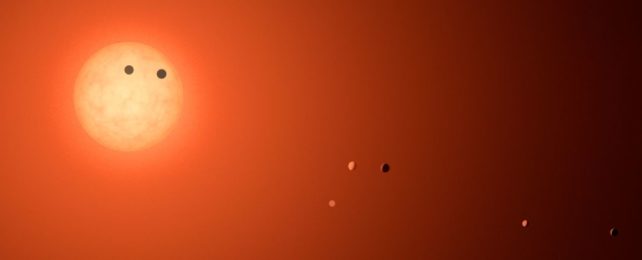There's something very peculiar about Earth, aside from all the organisms crawling all over it. It's our star, the Sun, that's weird: It's a yellow dwarf.
Sun-like stars are a minority in the Milky Way. It's estimated that fewer than 10 percent of the stars in our galaxy are G-type stars, like the Sun.
The most abundant stars are those we can't even see with the naked eye: red dwarfs. They're only up to about half the mass of the Sun, cool, dim, and with the longest lifespans of any stars.
These stellar lightweights account for up to 75 percent of all the stars in the Milky Way. One would therefore think, statistically, that if life were to emerge anywhere, it would be on a planet around a red dwarf.
Yet here we are, with our yellow Sun. This discrepancy between expectation and reality is known as the Red Sky Paradox, and scientists have yet to figure it out.
A new paper, accepted into The Astrophysical Journal Letters and uploaded to preprint server arXiv while it undergoes peer review and publication, could have a clue.
Basically, it seems like it might be much harder for life as we know it to get started in red dwarf planetary systems – because they lack the asteroid and gas giant architecture to deliver the ingredients for life to Earth-like worlds.
The results could have implications for our search for life outside the Solar System, especially since exoplanets defined as "potentially habitable" are often found in orbit around red dwarf stars.
Red dwarfs, in some respects, are some of the most promising targets in our search for habitable worlds. Because they are so small, they burn through their hydrogen fuel much more slowly than Sun-like stars do.
They can hang around for potentially trillions of years – much longer than the estimated 10 billion-year lifespan of the Sun and even the 13.8 billion-year age of the Universe. This means there's more time available for life to emerge and potentially thrive.
Red dwarfs also represent an opportunity for our current detection methods. Because they burn so slowly, they are cooler and dimmer than the Sun. This means that the habitable zone – the distance range from the star in which habitable temperatures can be found – is much closer. Recently, astronomers discovered an exoplanet in the habitable zone of a red dwarf star with an orbit of just 8.4 days.
But it seems like life's emergence and continued existence might be a tricky thing.
Previous studies have suggested that red dwarfs might not present the most hospitable environment. For example, such stars tend to be very active, frequently erupting with flares that would lash any close planets with radiation.
The authors of the new paper – astronomers Anna Childs, Rebecca Martin, and Mario Livio of the University of Nevada, Las Vegas – wanted to determine if red dwarf systems had enough of the ingredients that we think kick-started life on Earth.
Current studies suggest that asteroid and comet bombardment relatively late in the Solar System's youth altered Earth's crust in ways that made it more hospitable to life and delivered many of the chemical ingredients necessary for it.
Without an asteroid belt, therefore, the terraforming and chemical delivery systems for life are significantly reduced.
Models suggest that the formation of a stable asteroid belt, and late asteroid bombardment, requires the presence of a gas giant beyond a distance from the star known as the snow line, beyond which volatile compounds condense into solid ice. This is because such a gas giant can gravitationally interact with the asteroid belt, causing instabilities that pelt asteroids inwards towards the habitable zone.
So the researchers looked at red dwarf systems to see if they could find one of these gas giants.
There are currently 48 red dwarf stars with confirmed, rocky exoplanets orbiting in the habitable zone. Of these, 27 have more than one exoplanet. Of that group, 16 have mass measurements for the exoplanets in the system.
Defining a gas giant as a planet between 0.3 and 60 times the mass of Jupiter and calculating the position of the snow line for those systems, the team went looking for gas giants.
They found that none of the systems with a rocky, Earth-like planet in the habitable zone had a known gas giant as well.
Statistically, the team calculated, that there is a population of giant exoplanets orbiting red dwarf stars beyond the snow line. This means that, theoretically, red dwarf stars can have asteroid belts.
It's just that none of the known red dwarf systems with habitable zone rocky worlds are likely among that category, suggesting that red dwarf planetary system architecture can be wildly different from the Solar System we know and love.
There are a lot of assumptions at play. For example, maybe asteroid impacts aren't all that important. Maybe life on red dwarf exoplanets doesn't look at all like life on Earth. Maybe we're overestimating the significance of the habitable zone.
However, based on our current knowledge and understanding of life, things aren't looking great for red dwarf planets.
"The lack of giant planets in the (so far) observed systems containing habitable zone exoplanets suggests that these systems are unlikely to harbor an asteroid belt and the mechanism required for late-stage asteroid delivery to the habitable zone," the researchers write.
"Therefore, if asteroid impacts are indeed necessary for life, it is unlikely that the observed planets in the habitable zone harbor life."
And, in turn, that might be at least partially why our home planet isn't orbiting one of these cranky little red stars.
The research has been accepted into The Astrophysical Journal Letters and is available on arXiv.
